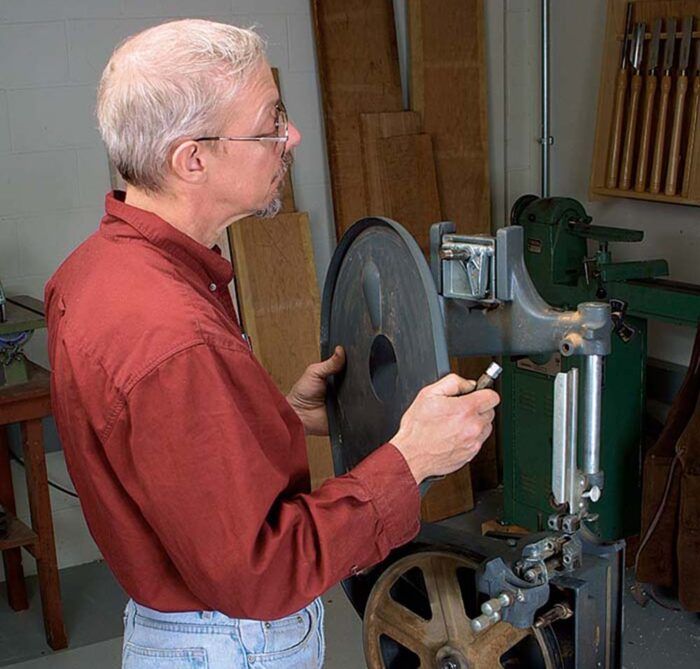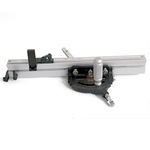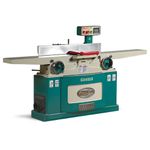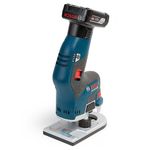Bandsaw Tune-Up
In just a few steps you can make an old bandsaw run like new.

Synopsis: Fine Woodworking’s shop manager John White makes tuning up your bandsaw less complicated. Using this article, you can go through the whole machine step by step, aligning pulleys, the table, and wheels, and clean and lubricate guide assemblies. You’ll see how to check the tires, drive belts, guide components, and bearings. White includes a troubleshooting chart for other issues, too. Side information shows how to install a bandsaw blade.
A poorly tuned bandsaw will cause nothing but frustration. But the tune-up process is straightforward, takes only a few hours and is certainly worth the trouble. The procedure of making a bandsaw behave consists of two basic steps: tuning up the machine and then adjusting it for the blade being used and the work being done.
In this article, I’ve broken down the tune-up process into its main components, allowing you to go through the whole machine step by step. During tune-up, the machine’s wheels, drive pulleys and table are brought into alignment, and the guide assemblies are cleaned and lubricated. Also, the machine’s tires, drive belts, guide components and bearings are checked and, if necessary, replaced. Once a bandsaw has been tuned up properly, setting it up for the blade and work at hand is quick and simple. If you run into problems in the future, use the chart at right to help troubleshoot the machine.
 |
 |
 Tension
Tension
The tensioning-and-tracking assembly controls the position of the upper wheel. Remove the upper wheel and cover to get at the assembly. Inspect the pivoting casting that supports the axle for cracks or bends from overtensioning. A cracked or bent casting should be replaced. If the axle is loose, which is common, don’t worry—it will tighten up when tension is applied. Use a light oil to lubricate the pivot pin.
After a few years of use, the slides on both sides of the square main casting will probably have a step worn into them—use a file to smooth down the worn faces and the sharp edges left on the top of the grooves in the casting. Use a stick lubricant on the slides before sliding the assembly back into the frame.
The original tensioning spring on a 14-in. bandsaw is almost always crushed, making it impossible to tension the blade properly. The spring can be replaced with a heavy-duty version from Iturra Designs (888-722-7078) without having to remove the upper wheel and blade cover (see the photo above and FWW #147, p. 83).
The last step in servicing the top end of the saw is to remove the tension and tracking bolts—clean the threads with a wire brush and round off the ends with a file. Use a stick lubricant on the bolts before you reinstall them.


Wheels
Having the upper wheel aligned directly above the lower wheel allows the bandsaw blade to track better and puts less stress on the saw and the blade. On a 14-in. bandsaw, checking the alignment is easy. Remove the table and lay a long straightedge across the faces of both wheels. If the wheels are out of alignment, you’ll see a gap between the straightedge and one wheel. On a Delta saw, the wheel alignment is adjusted by adding or removing shims on the upper axle. On Jet and most other Taiwanese-made saws, the upper wheel can’t be shimmed without placing excess pressure on the wheel bearings. These saws are aligned by shimming behind the lower wheel. Iturra Designs sells inexpensive sets of graduated shims for both Delta and imported bandsaws.


Checking and replacing wheel bearings
To test the wheel bearings, remove the saw’s blade and rotate the wheel through several revolutions with the tip of a finger against one of the spokes. You may feel a slight drag, but the motion should be smooth and silent. Even small amounts of roughness or a grinding sound indicate a contaminated bearing. If there is only a small amount of catching, the saw is still usable, but new bearings should be installed soon. If there is continuous roughness or grinding noises, the saw shouldn’t be used until new bearings have been installed.
 |
 |
Out with the old, in with the new. A bandsaw wheel has two bearings: Even if only one is failing, they should both be replaced. The wheel bearings must be tapped out with a hammer and punch (left). When installing a new bearing, gently tap it into place using a soft hammer against the outer race (right).
Tires
Tires are simply oversized rubber bands. But they should be checked regularly because the rubber becomes worn, cracked, or hardened and can cause tracking problems and vibration. A tire should have an obvious crown and be smooth and free of grooves. Press your thumbnail into the tire; it should press in easily, and the surface should spring back. A lack of spring-back is a sign that the tire has hardened and needs to be replaced. To remove a tire, use a screwdriver to lift it over the rim. If the old tire was glued on, clean off the adhesive using acetone. The new tire should snap into a groove in the rim of the wheel (see the photos below).
 |
 |
Installing a tire. Stretch the tire over the wheel (left). To even out the tension on the tire, slide a screwdriver between the wheel and tire, then rotate the wheel while holding the screwdriver in one spot (right).
Table
To get square cuts on a bandsaw, the table must be aligned square to both the sides and back of the blade. To align the table, first back off the blade guides and then adjust the blade to full tension and proper tracking. Place a square on the side of the blade and adjust the stop bolt (see the middle photo at left) to square up the table. Once the table has been adjusted, zero out the pointer on the table-tilt scale. To square, the table to the back of the blade, loosen the table bolts from underneath, remove the table, and place shims between the trunnions and the table casting. This process may take a little trial and error, but you only have to do it once, and it is definitely worth the time.
Aligning Front To Back
 |
Aligning Side To Side
 |
Blade Guides

The guide assemblies on a 14-in. saw are mechanically simple but have a number of parts that can wear out or jam up. Start by replacing any thrust bearing that is noisy or won’t rotate freely. Then remove the bearing support and guide-block holders, file off any paint and burrs and inspect all parts for cracks or worn threads. Remove all of the setscrews and round off their ends with a file—the smoothed ends will hold better. Remove the knob that locks the guidepost and shape the tip of its threaded end to match the groove in the guidepost. Clean and lubricate the threads and the other parts of the guides as you reassemble them.
The guide blocks should be smooth, flat, and square. Clamp the blocks in the holder with their faces touching; there should be no gaps between the blocks.
The lower guide assembly on the Delta 14-in. bandsaw is more complex than the upper guide assembly, but the same logic applies to tune-up. The lower guide assembly on a Taiwanese-made saw is tuned up the same way as the upper guide assembly.


From Fine Woodworking #157
For the full article, download the PDF below:
Fine Woodworking Recommended Products

JessEm Mite-R Excel II Miter Gauge

Grizzly G0495X Industrial Helical Cutterhead 8-in. Jointer

Bosch 12V Trim Router









Comments
I think the title of this article i meant to read " In just a few steps you CAN make an old bandsaw run like new"
If you'd like some help proofreading articles i'd be happy to help!
Log in or create an account to post a comment.
Sign up Log in